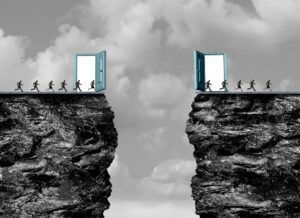“Life itself still remains a very effective therapist.”
~Karen Horney, M.D. (1885 – 1952)

The Scene. The coaching discussions I have had lately, while virtual, have been some of the most meaningful of my career. Clients grapple with the immediacy of business, leadership, and humanitarian decisions that were unforeseen a mere 30-60 days ago: “How can I best balance business continuity against various forms of negative impact on individual wellbeing?” Or “How do I make these decisions without more data or experience in situations like this?” And “What should I be doing to lead myself and the people I care about through these uncertain times?” These compelling questions emerge and then continue to reverberate across multiple sessions.
Typical conversations go something like this:
Leader: “I feel like we’re past the initial stage of this crisis, when it was ‘all hands on deck.’ Now I see people caught between two worlds. The frenetic energy of the first stage is dropping. People are getting tired and cranky. It’s hard to keep them motivated.”
Me: “How do you see others behaving in this in-between place? And what are you feeling and doing?”
Leader: “Some people are still really wanting to stay in the high action mode, to stay in motion. I see them trying to create a dramatic kind of energy. So, I am trying to manage that, to make sure it stays effective. But I am also seeing other people drop off or not show up like I would expect them to. I am not sure where they’ve gone. And then I’m also seeing people who seem to need more contact with me, who are setting up lots of videoconferences and send update emails on relatively unimportant stuff that I don’t think are necessary…Overall, it’s just feeling hard and draining and negative. But I’m trying to be patient and recognize we are all stuck in some sort of in-between period.”
Liminal space has been thrust upon us all.
Liminal Space, Revisited. What is liminal space? The Latin root, “limen,” is a noun that means threshold, border, or beginning. “Liminal,” the adjective form, has been defined as:
- Relating to a transitional or initial stage of a process
- Occupying a position at, or on both sides of, a boundary or threshold
The original term, coined in cultural anthropology circles, describes the time in a cultural or tribal ritual where an actual transformation is occurring (e.g. from child to adult). It has also been used in traditional storytelling and mythology to depict a particular phase in a hero or heroine’s journey. More recently, the concept has been adopted and broadened by Jungian psychologists, spiritualists, and others to represent potent spaces of transformation when an individual, group or culture is no longer in a previous state but is not yet in the new state; when old ways of being no longer work but the new ways have not yet emerged.
I introduced the concept of liminal space in a prior post. I invite you to visit that post for a more thorough discussion of the roots of the term and general recommendations for leading in liminal space. This post focuses more on the very significant (and uncomfortable) experience of prolonged stress that is one of the defining characteristics of a liminal period. Three coping strategies – common behavioral patterns with which we try to manage that stress – are outlined, along with a set of self- and leadership reflections.
All of this is offered from a belief that, while the pandemic form in which this liminal space has come is deeply unwelcome, it (“life itself,” as the opening quote suggests) serves up a rich, and in some measure, a redemptive, opportunity to grow.
Our Stressed Selves. Several years ago, the American Psychological Association reported the average stress level of a representative American sample as 5.1 on a 10-point scale. The top five rated stressors (and the percent who rated each stressor as either “very” or “somewhat significant”) are:
- Money (67%)
- Work (65%)
- Family Responsibilities (54%)
- Personal Health (51%)
- Health Problems Affecting the Family and the Economy (tied at 50%)
Would a re-survey now find a significant increase in the average stress level, along with some of the stressors having flipped position on the list? I would guess the answer is “yes.”
But don’t take my answer for it. Try a quick self-assessment: on a scale of 1 (“little or no stress”) to 10 (“ a great deal of stress”), how would you rate your current level of stress in each of the six areas covered by the APA’s Stress in America survey?
____ Money
____ Work
____ Family Responsibilities
____ Personal Health
____ Health Problems Affecting My Family
____ The Economy
Now, how would your ratings have looked six, or even three, months ago?
Most of us are walking around these days in the midst of an elevated stress experience, largely created by having a collective experience of feeling tremendous uncertainty around important factors related to our perceived personal safety and well-being. This collective experience is eminently reasonable and understandable. So, what can we do, if anything, to get through this liminal experience with a little bit more ease? Or even, possibly, to emerge out the other side of it as a stronger version of the selves that entered into it?
This post will suggest one approach. Future posts will provide additional approaches.
Three Coping Strategies. The more forward-looking leadership teams and leaders I am in touch with have spent time discussing “stress behaviors” they are seeing among their team members and ways to understand those behaviors. They are also eager to understand and receive some support for their own tendencies under stress. The story I opened with is representative of leaders’ attempts to note and make sense of the individual differences that are showing up under prolonged stressful conditions.
We can view stress behaviors as clues, or outward manifestations, of our own and others’ underlying coping strategies. How do we best make sense of those clues? By looking for patterns among them.
Many stress behaviors fall into one of three types of energetic patterns, according to an influential body of thought pioneered by the humanistic psychoanalyst, Karen Horney, M.D. In brief, our attempts to cope with stress and, in longer-lasting states, anxiety, tend to fall along three dimensions: we either move against people (in aggression or power-seeking behavior), we move away from people (in withdrawal or avoidance behavior), or we move toward people (in compliance or approval-seeking behavior).
Each of these energetic patterns can be viewed as having associated biologically-wired circuitry: fight (against) versus flight (away) versus tend-and-befriend (toward) instincts that have long served a purpose in the human animal. Thus, each pattern retains, at its core, a healthy, life-enhancing property: moving against is about assertiveness, moving away is about taking some distance to gain perspective, and moving toward is about cooperation.
We can, and probably do, use all three orientations across time and different situations. But many of us are likely to have an underlying predisposition toward one pattern, what Horney calls “those ways and means of coping with others in which the particular person feels most at home,” based on childhood/developmental experiences. We also tend to overuse, or return to this “home,” during times of stress.
What might each of these strategies look like in action, in work relationships and situations, during a stressful time? I’ve supplied some thumbnail descriptions below:

It is important to note that these descriptions are extremely high level. How you might exhibit “moving away” behavior, for example, could look very different from someone else you work with: you might become very intellectualized to mask how you actually feel about a “charged” work issue whereas a peer starts skipping videoconferences related to that issue. What will be most similar is the psychological purpose it serves within both of you: to help you manage stress and/or to help you feel safer by creating either actual or psychological distance from the work issue.
How to Use This? So, how might you translate this model from concept to action?How might the framework help you as a leader and as a person encountering heightened stress? First, knowledge can be powerful. This triarchic model has legs. Many clients I’ve introduced to it have found it to be a useful lens through which to be curious about what they see in any number of situations: from understanding their own or another person’s behavior over time, to forming a hypothesis about patterns in a team (e.g. what do you get when you lead a team in which half the members tend toward “move against” and the other half tend toward “move away” attitudes?) Additionally, several personality and leadership assessments integrate Karen Horney’s three dimensions into their theoretical framework: the Hogan Development Survey, the Leadership Circle Profile, and the Enneagram, to name a few. But you need not wait to get formal diagnostic data back. Generally, I find you can follow the behavioral clues to form a hypothesis and then test that hypothesis by seeing how useful it is as an explanatory vehicle for future behaviors. Or, most powerfully, if you take action to proactively address the “solve for” part of the tendency in a healthier manner.
Second, if you are looking to use this system to increase self-awareness, it can be helpful to seek feedback from others with whom you are interacting during this stressful time. As James Hollis, Ph.D., a prolific author, and Jungian analyst, stated: “Self-awareness has nothing to do with intelligence or intention. It is hard to step outside your stuff and reflect upon it.”
You might simply ask: “What are you noticing in the way I have been behaving over the last several weeks?” Or, a little more leading question if you don’t net much from that first one: “Do you find me behaving in ways that are seeming to bring me closer to or farther away from you (or others)? How effective am I being in responding to various situations that arise?”
Third, you can work (or coach someone else) through the following set of self-reflections as a means of restoring your center of gravity, such that you are better able to pull from the strengths offered by your predisposed strategy while introducing more balance:
- How might I take a more assertive, direct approach to this situation? What would that look like?
- How might I take a more measured, objective approach to this situation? What would that look like?
- How might I take a more collaborative, conscientious approach to this situation? What would that look like?
Last, know that the following premise underlies this model: once we move beyond these coping strategies, we touch our uniquely human inheritance as wholehearted beings. I’ll close with another powerful quote from Karen Horney, from her perch as a mid-twentieth-century Neo-Freudian and early holistic practitioner: “The comprehensive formulation of [developmental] goals is the striving for wholeheartedness: to be without pretense, to be emotionally sincere, to be able to put the whole of oneself into one’s feelings, one’s work, one’s beliefs.”
How much more wonderful might this period on earth be made if we were all creating more from wholeheartedness instead of from fear?
Recent Posts
“Life itself still remains a very effective therapist.”
~Karen Horney, M.D. (1885 – 1952)

The Scene. The coaching discussions I have had lately, while virtual, have been some of the most meaningful of my career. Clients grapple with the immediacy of business, leadership, and humanitarian decisions that were unforeseen a mere 30-60 days ago: “How can I best balance business continuity against various forms of negative impact on individual wellbeing?” Or “How do I make these decisions without more data or experience in situations like this?” And “What should I be doing to lead myself and the people I care about through these uncertain times?” These compelling questions emerge and then continue to reverberate across multiple sessions.
Typical conversations go something like this:
Leader: “I feel like we’re past the initial stage of this crisis, when it was ‘all hands on deck.’ Now I see people caught between two worlds. The frenetic energy of the first stage is dropping. People are getting tired and cranky. It’s hard to keep them motivated.”
Me: “How do you see others behaving in this in-between place? And what are you feeling and doing?”
Leader: “Some people are still really wanting to stay in the high action mode, to stay in motion. I see them trying to create a dramatic kind of energy. So, I am trying to manage that, to make sure it stays effective. But I am also seeing other people drop off or not show up like I would expect them to. I am not sure where they’ve gone. And then I’m also seeing people who seem to need more contact with me, who are setting up lots of videoconferences and send update emails on relatively unimportant stuff that I don’t think are necessary…Overall, it’s just feeling hard and draining and negative. But I’m trying to be patient and recognize we are all stuck in some sort of in-between period.”
Liminal space has been thrust upon us all.
Liminal Space, Revisited. What is liminal space? The Latin root, “limen,” is a noun that means threshold, border, or beginning. “Liminal,” the adjective form, has been defined as:
- Relating to a transitional or initial stage of a process
- Occupying a position at, or on both sides of, a boundary or threshold
The original term, coined in cultural anthropology circles, describes the time in a cultural or tribal ritual where an actual transformation is occurring (e.g. from child to adult). It has also been used in traditional storytelling and mythology to depict a particular phase in a hero or heroine’s journey. More recently, the concept has been adopted and broadened by Jungian psychologists, spiritualists, and others to represent potent spaces of transformation when an individual, group or culture is no longer in a previous state but is not yet in the new state; when old ways of being no longer work but the new ways have not yet emerged.
I introduced the concept of liminal space in a prior post. I invite you to visit that post for a more thorough discussion of the roots of the term and general recommendations for leading in liminal space. This post focuses more on the very significant (and uncomfortable) experience of prolonged stress that is one of the defining characteristics of a liminal period. Three coping strategies – common behavioral patterns with which we try to manage that stress – are outlined, along with a set of self- and leadership reflections.
All of this is offered from a belief that, while the pandemic form in which this liminal space has come is deeply unwelcome, it (“life itself,” as the opening quote suggests) serves up a rich, and in some measure, a redemptive, opportunity to grow.
Our Stressed Selves. Several years ago, the American Psychological Association reported the average stress level of a representative American sample as 5.1 on a 10-point scale. The top five rated stressors (and the percent who rated each stressor as either “very” or “somewhat significant”) are:
- Money (67%)
- Work (65%)
- Family Responsibilities (54%)
- Personal Health (51%)
- Health Problems Affecting the Family and the Economy (tied at 50%)
Would a re-survey now find a significant increase in the average stress level, along with some of the stressors having flipped position on the list? I would guess the answer is “yes.”
But don’t take my answer for it. Try a quick self-assessment: on a scale of 1 (“little or no stress”) to 10 (“ a great deal of stress”), how would you rate your current level of stress in each of the six areas covered by the APA’s Stress in America survey?
____ Money
____ Work
____ Family Responsibilities
____ Personal Health
____ Health Problems Affecting My Family
____ The Economy
Now, how would your ratings have looked six, or even three, months ago?
Most of us are walking around these days in the midst of an elevated stress experience, largely created by having a collective experience of feeling tremendous uncertainty around important factors related to our perceived personal safety and well-being. This collective experience is eminently reasonable and understandable. So, what can we do, if anything, to get through this liminal experience with a little bit more ease? Or even, possibly, to emerge out the other side of it as a stronger version of the selves that entered into it?
This post will suggest one approach. Future posts will provide additional approaches.
Three Coping Strategies. The more forward-looking leadership teams and leaders I am in touch with have spent time discussing “stress behaviors” they are seeing among their team members and ways to understand those behaviors. They are also eager to understand and receive some support for their own tendencies under stress. The story I opened with is representative of leaders’ attempts to note and make sense of the individual differences that are showing up under prolonged stressful conditions.
We can view stress behaviors as clues, or outward manifestations, of our own and others’ underlying coping strategies. How do we best make sense of those clues? By looking for patterns among them.
Many stress behaviors fall into one of three types of energetic patterns, according to an influential body of thought pioneered by the humanistic psychoanalyst, Karen Horney, M.D. In brief, our attempts to cope with stress and, in longer-lasting states, anxiety, tend to fall along three dimensions: we either move against people (in aggression or power-seeking behavior), we move away from people (in withdrawal or avoidance behavior), or we move toward people (in compliance or approval-seeking behavior).
Each of these energetic patterns can be viewed as having associated biologically-wired circuitry: fight (against) versus flight (away) versus tend-and-befriend (toward) instincts that have long served a purpose in the human animal. Thus, each pattern retains, at its core, a healthy, life-enhancing property: moving against is about assertiveness, moving away is about taking some distance to gain perspective, and moving toward is about cooperation.
We can, and probably do, use all three orientations across time and different situations. But many of us are likely to have an underlying predisposition toward one pattern, what Horney calls “those ways and means of coping with others in which the particular person feels most at home,” based on childhood/developmental experiences. We also tend to overuse, or return to this “home,” during times of stress.
What might each of these strategies look like in action, in work relationships and situations, during a stressful time? I’ve supplied some thumbnail descriptions below:

It is important to note that these descriptions are extremely high level. How you might exhibit “moving away” behavior, for example, could look very different from someone else you work with: you might become very intellectualized to mask how you actually feel about a “charged” work issue whereas a peer starts skipping videoconferences related to that issue. What will be most similar is the psychological purpose it serves within both of you: to help you manage stress and/or to help you feel safer by creating either actual or psychological distance from the work issue.
How to Use This? So, how might you translate this model from concept to action?How might the framework help you as a leader and as a person encountering heightened stress? First, knowledge can be powerful. This triarchic model has legs. Many clients I’ve introduced to it have found it to be a useful lens through which to be curious about what they see in any number of situations: from understanding their own or another person’s behavior over time, to forming a hypothesis about patterns in a team (e.g. what do you get when you lead a team in which half the members tend toward “move against” and the other half tend toward “move away” attitudes?) Additionally, several personality and leadership assessments integrate Karen Horney’s three dimensions into their theoretical framework: the Hogan Development Survey, the Leadership Circle Profile, and the Enneagram, to name a few. But you need not wait to get formal diagnostic data back. Generally, I find you can follow the behavioral clues to form a hypothesis and then test that hypothesis by seeing how useful it is as an explanatory vehicle for future behaviors. Or, most powerfully, if you take action to proactively address the “solve for” part of the tendency in a healthier manner.
Second, if you are looking to use this system to increase self-awareness, it can be helpful to seek feedback from others with whom you are interacting during this stressful time. As James Hollis, Ph.D., a prolific author, and Jungian analyst, stated: “Self-awareness has nothing to do with intelligence or intention. It is hard to step outside your stuff and reflect upon it.”
You might simply ask: “What are you noticing in the way I have been behaving over the last several weeks?” Or, a little more leading question if you don’t net much from that first one: “Do you find me behaving in ways that are seeming to bring me closer to or farther away from you (or others)? How effective am I being in responding to various situations that arise?”
Third, you can work (or coach someone else) through the following set of self-reflections as a means of restoring your center of gravity, such that you are better able to pull from the strengths offered by your predisposed strategy while introducing more balance:
- How might I take a more assertive, direct approach to this situation? What would that look like?
- How might I take a more measured, objective approach to this situation? What would that look like?
- How might I take a more collaborative, conscientious approach to this situation? What would that look like?
Last, know that the following premise underlies this model: once we move beyond these coping strategies, we touch our uniquely human inheritance as wholehearted beings. I’ll close with another powerful quote from Karen Horney, from her perch as a mid-twentieth-century Neo-Freudian and early holistic practitioner: “The comprehensive formulation of [developmental] goals is the striving for wholeheartedness: to be without pretense, to be emotionally sincere, to be able to put the whole of oneself into one’s feelings, one’s work, one’s beliefs.”
How much more wonderful might this period on earth be made if we were all creating more from wholeheartedness instead of from fear?





